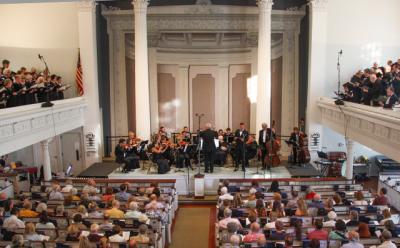Stirring Concert Pairs Two Commissions

You’ve heard of the classical “three Bs” — Bach, Beethoven, and Brahms. Well, there are more than three notable composers whose last names begin with the second letter of the alphabet, and you can include Victoria Bond in that extended list. Ms. Bond, a well-known conductor and music commentator, is also a composer of considerable ingenuity.
The pairing of “The Reluctant Moses,” her new commission, with an old but little-known commission, the Mass in C by Beethoven, was the subject of the stirring 70th anniversary finale concert by the Choral Society of the Hamptons and South Fork Chamber Orchestra under the estimable direction of Mark Mangini, which took place Saturday evening at the 172-year-old Old Whalers Church in Sag Harbor.
I have known Victoria Bond and her work for many years and she has conducted my music. I was pleased to have an opportunity to hear this work in its world premiere.
For a subject, Ms. Bond reached back to the Old Testament scene in which Moses encounters the burning bush and the voice of God commanding him to lead his people out of Egypt. In this highly successful modern telling of an ancient story, Moses is a bass accompanied by a bass (a string double bass, that is).
In fact, bass sounds are everywhere in this piece, which includes a bass clarinet, a French horn imitating a bass tuba (according to the composer, intended to evoke the ancient Hebrew shofar), and, of course, the bass section of the chorus which, along with the soprano, alto, and tenor sections, takes the role of the voice of God. The use of bass sounds adds a suitable gravity, but this is, by no means, a bottom-heavy piece. There is a striking and imaginative use of a wide palette of orchestral sound coupled with strong vocal writing that culminates in an emotional, contrapuntal setting of the Ten Commandments.
The bass singer, Joseph Charles Beutel, was not the older, stern Moses we associate with the Old Testament prophet but rather a more youthful, hesitant figure whose dignity was enhanced by John Feeney’s knobby, insistent double bass interventions. Playing God in the burning bush to Ms. Bond’s highly developed musical setting was not an easy assignment for the chorus, but they handled it with the strength and musicality that it deserved.
The soloists for the Beethoven Mass in C, which followed, were Ileana Santamaria, soprano, Charlene Marcinko, mezzo-soprano, and Sean Christensen, tenor, in addition to Mr. Beutel.
The Mass in C (not to be confused with Beethoven’s later and much better-known Missa Solemnis) was commissioned by Nikolaus II of Esterhazy. This Austro-Hungarian aristocrat partially restored his grandfather’s famous and influential musical establishment and started a program of commissioning a new setting of the Catholic Mass every year. Haydn wrote no less than six Masses for him (or rather, for his wife); after Haydn retired in 1802, the annual job went to other composers. Beethoven’s turn came in 1807, and he responded magnificently with an imaginative and moving work that Nikolaus hated. Beethoven’s Mass, he said, was unbearably ridiculous and detestable; he was not convinced that it could ever be performed properly. Beethoven left town in a huff, and the piece fell into relative obscurity.
Nikolaus was wrong, and the Hamptons chorus obviously outdid the Esterhazy chorus. The Mass in C was performed more than properly on Saturday night, and its highly original score was revealed as a power house of the composer’s middle period, well deserving of revival.
Beethoven was already becoming quite deaf, and his vocal writing, often off the charts and a challenge to any chorus, had energy, clarity, and lyricism in this performance. The four soloists — deftly woven into the choral and orchestral textures — made an excellent ensemble, while the orchestra, struggling somewhat due largely to the small number of strings, was equally lively and lyrical in a work that alternates the hammer blows of the Fifth Symphony and the pastorale idiom of the Sixth, both roughly contemporaneous with the Mass in C.
I should add that there was just enough room in the church’s altar area to accommodate the orchestra (with its 11 strings) along with the conductor and four soloists. Even the timpani had to be placed off to the side at audience level, and the 56-voice chorus was necessarily divided between the church balconies, which reach all the way to the front of hall — the high voices on the left, the lower voices on the right. This produced an antiphonal effect, perhaps not quite intended by the composer but not ineffective, and it gave the chorus a presence and immediacy quite different from the usual positioning of choral singers on stage behind the orchestra. Mr. Mangini, the longtime director of the Choral Society (since 2001), provided solid musical leadership for both Bs.
Eric Salzman is a composer and writer working mainly in the development of a new music theater. His most recent major theater opera, “Big Jim and the Small-time Investors,” is about a con man who has convinced people to invest in his new invention, a virtual-reality machine. Mr. Salzman’s music can be found on the Labor/Naxos label, and he is the co-author, with Thomas Desi, of “The New Music Theater: Hearing the Body, Seeing the Voice.”
